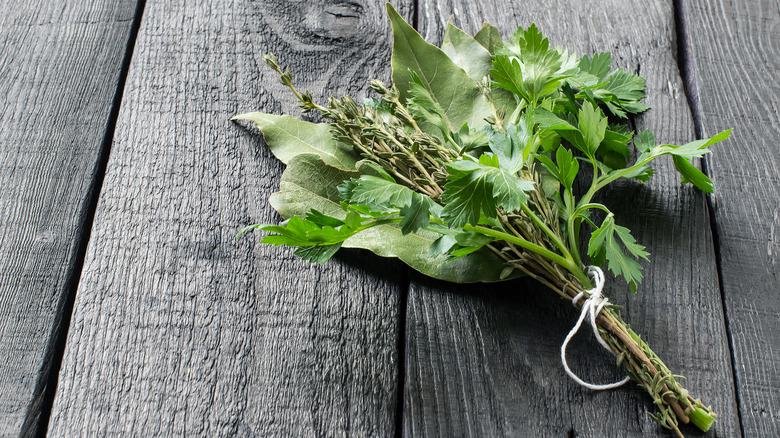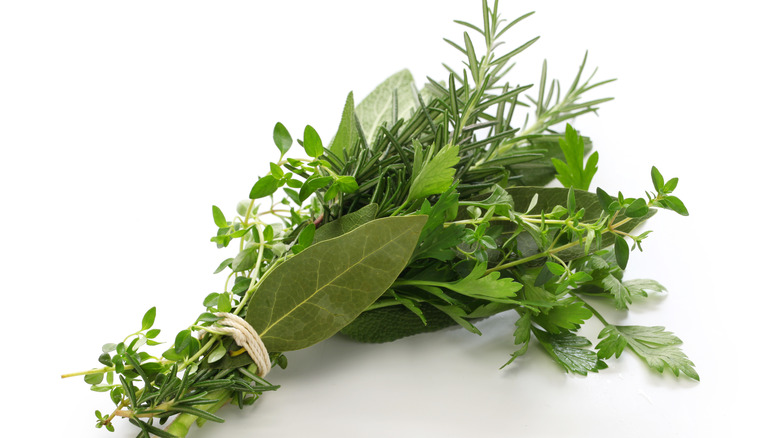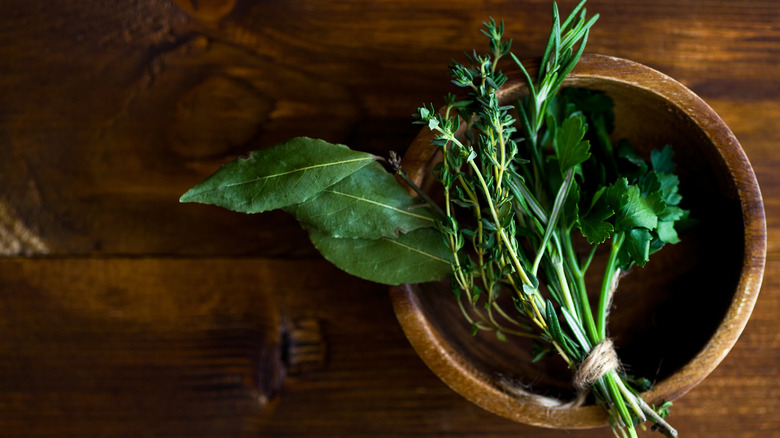What Is A Bouquet Garni And How Is It Used?
While the term "bouquet garni" may not be immediately recognizable, we're certain that its flavor is one that you've encountered on many occasions. From flavoring stocks to imbuing soups, stews, and braised meats with herbaceous flavor, a bouquet garni is a multi-purpose culinary tool that imparts rich flavor to a slew of your favorite dishes.
Don't be spooked by its name; it's literally defined as "garnished bouquet." Pretty self-explanatory! A bouquet garni is no more than a fragrant, tied bundle of varying herbs, aromatics, vegetables, spices, etc. A "classic" bouquet garni contains thyme, parsley, and bay leaves, but there really is no need to limit what ingredients may be included. Although there are no set rules, parsley tends to be a non-negotiable; it is the backbone of the bouquet garni and almost always present.
Taste notes that the bouquet garni originated in French Provencal cooking and was used as early as the 1600s. It is especially helpful because it allows for simple removal at the end of the cooking process and often results in a more thorough flavor infusion than merely sprinkling some chopped herbs into the dish as a garnish.
How do you make a bouquet garni?
There are multiple ways to tie together your bouquet garni. Some, if only using herbs and herb stems, require merely high-quality kitchen twine. Others — especially those containing small spices or seeds — require cheesecloth or a sachet. And others are dual-purpose, sometimes even using the root end of a leek or another vegetable to act as the "wrapper" to contain the other ingredients. This method also imbues the final dish with a subtle allium flavor. Win-win!
Bouquet garnis can be purchased already prepared in either dried or fresh variations, or you may prepare your own with whatever herbs and flavorings your heart desires. Some other common inclusions are rosemary, thyme, bay, oregano, marjoram, sage, and basil. Beyond herbs, many also use spices, vegetables, seeds, and more, ranging anywhere from fennel fronds and juniper berries to Szechuan peppercorns or lemongrass. Using whatever flavor profile is inherent in your dish, capitalize and bolster that flavor with a well-intentioned bouquet garni.
What other ingredients can be included in a bouquet garni?
Some herbs also lend themselves more so to very light cooking times, whereas others can be cooked for hours on end and retain their structural integrity and flavor. Also, be sure to keep in mind that some herbs are much more robust than others, so be mindful of that when preparing a bouquet garni.
Other ideas for possible inclusions are sage, tarragon, oregano, chervil, cilantro, chives, or even garlic. Cumin, coriander, star anise, fennel fronds, ginger, and other ingredients of that ilk are also great options. Citrus fruits such as lemon or orange zest may also be included. There really is no limit to the number of options! If you opt to use a bouquet garni the next time you cook, you're sure to impress your guests — and yourself — with the deep, rich flavor of your next soup, stew, braise, or sauce.
A bouquet garni takes almost no time to put together but helps to hugely improve the flavor of many savory dishes. We couldn't recommend them enough.


